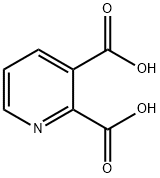
2,3-ピリジンジカルボン酸
化学名:2,3-ピリジンジカルボン酸
英語化学名:Quinolinic acid
CAS番号:89-00-9
分子式:C7H5NO4
分子量:167.12
EINECS:201-874-8
MOL File89-00-9.mol
| 融点 | 188-190 °C (dec.) (lit.) |
| 沸点 | 295.67°C (rough estimate) |
| 比重(密度) | 1.5216 (rough estimate) |
| 屈折率 | 1.6280 (estimate) |
| 貯蔵温度 | Keep in dark place,Sealed in dry,Room Temperature |
| 溶解性 | 10g/リットル |
| 外見 | 結晶性粉末 |
| 酸解離定数(Pka) | 2.43(at 25℃) |
| 色 | ホワイト~ライトイエローベージュ |
| 臭い (Odor) | 無臭 |
| 水溶解度 | 0.55g/100mL |
| Merck | 14,8073 |
| BRN | 137110 |
| InChIKey | GJAWHXHKYYXBSV-UHFFFAOYSA-N |
| CAS データベース | 89-00-9(CAS DataBase Reference) |
| EPAの化学物質情報 | 2,3-Pyridinedicarboxylic acid (89-00-9) |
| 主な危険性 | Xi |
| Rフレーズ | 36/37/38-33 |
| Sフレーズ | 26-36/37-24/25-37 |
| WGK Germany | 3 |
| RTECS 番号 | US7967250 |
| TSCA | T |
| 国連危険物分類 | IRRITANT |
| HSコード | 29333999 |
| 有毒物質データの | 89-00-9(Hazardous Substances Data) |
| 毒性 | Focal injection of quinolinic acid into specific areas of the brain produces neuronal damage although sparing axons of passage. Similarities between the biochemical and morphological profiles of these lesions and human neuropathy seen in neurodegenerative diseases have led to the proposal that endogenous excitotoxins may play a role in such neurodegenerative disease states. Quinolinic acid is an intermediate in the kynurenine pathway of tryptophan metabolism and has been detected in the brains of several mammals including man. The neuroexcitatory action is thought to be mediated via interaction with the N-methyl-D-aspartate (NMDA) receptor of the glutamate family. No mechanism for quinolinic acid removal, nor for synaptic inactivation, has been found, and consequently accumulation of concentrations capa_x0002_ble of inducing neuronal degeneration and death may occur. |